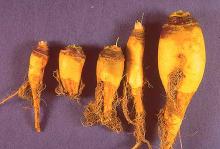See:
Radish (Raphanus sativus) - Black Root
Cause Aphanomyces raphani, a fungus-like microorganism that overwinters in soil and on diseased plant residue in soil. It invades the fine rootlets of young seedlings and develops resting spores in large numbers within the roots.
Symptoms The fine rootlets turn black and collapse. On the main taproot, dark surface lesions develop. With age, these enlarge into grayish black discolored areas of irregular size and shape just beneath the root surface. The main root may be girdled and plant growth interrupted until new roots form above the girdle. This is the most common symptom on rutabaga. Rutabagas in the six- to seven-leaf stage frequently wilt in the warm part of the day. Systemic infection occurs occasionally, resulting in darkened vascular tissue within a normal-looking root. Rhizoctonia solani may cause similar symptoms on turnip and rutabaga roots (wirestem and crater rot).
Cultural control
- If possible, do not plant any crucifer in infested fields for at least 3 years, and prevent cruciferous weeds during that time.
- The rutabaga 'American Purple Top' has good tolerance.
Chemical control
- Growers have obtained good control using soil fumigants.
Reference Ghafoor, A. 1964. Radish black-root fungus: Host range, nutrition and oospore production and germination. Phytopathology 54:1167-1171.


